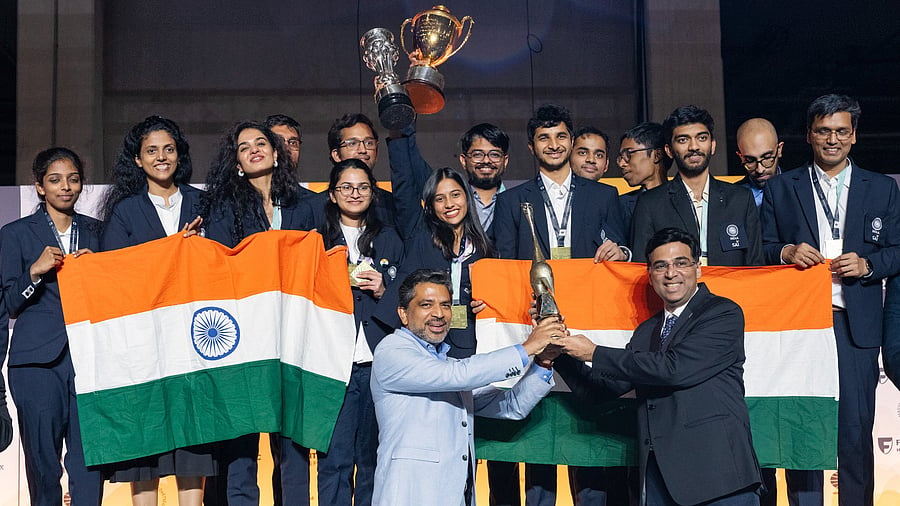
Triumphant Indian men's and women's teams at the Chess Olympiad.
Credit: FIDE
Bengaluru: Take a moment to picture this: A lone Indian warrior, locked in battle for decades, facing off against formidable opponents on a battlefield of black and white squares. No swords, no guns -- his only weapons were his mind and heart. There was no bloodshed, but his rivals left the arena with broken egos and shattered dreams.
In a chess world dominated by Russians, Chinese, and later, the great Magnus Carlsen of Norway, India’s Viswanathan Anand stood firm, fighting alone -- yet commanding the board like a king.
That solitary journey, however, is now history. The most celebrated “one-man army” in Indian sports has found his successors. A new generation -- young, hungry, and relentless -- is ready to carry forward the unparalleled legacy of ‘Vishy Sir’ -- India’s first Grandmaster, five-time world champion, and former World No. 1.
The past year, in particular, has been a turning point for Indian chess. Led by Arjun Erigaisi at No. 4, three Indians (including Anand at No. 10) now rank among the world’s top 10 men’s players, while five Indian women are in the top 50. The Indian men’s and women’s teams both clinched gold at the Chess Olympiad. At the Candidates Tournament, three of the eight contenders were Indians, and its winner, D Gukesh, went on to claim the world championship title. Koneru Humpy’s triumph in the World Rapid Chess Championship was the crowning glory of a remarkable 2024.
With this growing dominance, expectations have soared. Chess, a game that originated in India, finally seems to be returning to its roots. But despite the rising stars and numerous titles, skepticism still lingers. Can India truly claim the mantle as the sport’s next dominant force? A crucial element still seemed missing -- one that Anand himself recently pointed out.
“There’s now a large group of players. In almost every tournament, there’s an Indian you look forward to watching,” Anand remarked at an event in Bengaluru honoring D Gukesh’s world title win.
He added, “Now, people are keen to see if two Indians will battle for the title in a major event.”
Just a week ago, that vision became reality. At the Tata Steel Chess Tournament in Wijk aan Zee, Netherlands, R Praggnanandhaa defeated Gukesh to claim the trophy --marking a historic moment for Indian chess.
So, is the era of Indian dominance in world chess finally here?
While Grandmaster and mentor Pravin Thipsay doesn’t disagree, he urges the chess community to think long-term, emphasising the need for sustainable growth and holistic development. The pieces are in place -- the challenge now is to turn this golden moment into an enduring legacy.
“We predicted that 2024 will be the year for Indian chess. And it happened. About India’s dominance going forward, we have to develop the system simultaneously while focussing on these individual peaks.
“Continuity in getting good results, at all levels, will happen when there is support. And support will come when you are better than the others. So, in my opinion, the attention we have garnered now has to be used to further strengthen the base for the growth of the sport,” said Thipsay.
Speaking about attention of such a massive scale, Grandmaster Stany GA from Karnataka is of the opinion that it was what the chess players needed to change the face of the sport that was craving for spotlight.
“Earlier, Anand was the general public’s only reference point. Now, Gukesh, Pragg, Erigaisi, Vaishali (Rameshbabu), Divya (Deshmukh) have become household names. One reason why chess hadn’t taken off as it was meant to was because of a lack of superstars.
“These youngsters have changed that narrative and a revolution has taken place over the past two years. So, yes, the time has come for Indians to dominate world chess,” noted the 32-year-old from Bhadravati.
The 2025 chess calendar is a tricky one in the chart as it is without the big events such as the Olympiad or a World Championship. Both Thipsay and Stany agree that the coming months will be more about individual performances to prepare for a repeat of 2024 in 2026.
“Gukesh, the world champion, is set to meet Carlsen, the world’s No. 1 player, at the Norway Chess (in May). It will be interesting to witness how the match-up transpires.
“I think, more importantly, it is a year where we have to prepare a chasing pack to challenge the ones at the top,” said Thipsay.
“As a fan, I really wish that Erigaisi or Pragg can win the Candidates next year and challenge Gukesh for the world title. That will be brilliant,” offered Stany.
The then USSR and now Russia had stamped their authority over the sport for nearly 70 years in the last century. It could come across as wishful thinking to expect India to reach those heights from where it stands now on a 64-square checkered board.
However, the need to raise the bar to beat their own standards is a welcome change. Erigaisi, Gukesh, Praggnanandhaa, Vidit Gujrathi, Aravindh Chithambaram, Harikrishna Pentala, Nihal Sarin, Humpy, Vaishali, Divya, Harika Dronavalli, Vantika Agawal among others will be the names etched in history for starring in a new fearless era of Indian chess.
Hunting in packs was never this exciting in an individual sport as the battle for chess supremacy is heating up and how!
R Praggnanandhaa after winning the Tata Steel Chess Masters.
Credit: FIDE
D Gukesh with the FIDE World Chess Championship.
Credit: FIDE